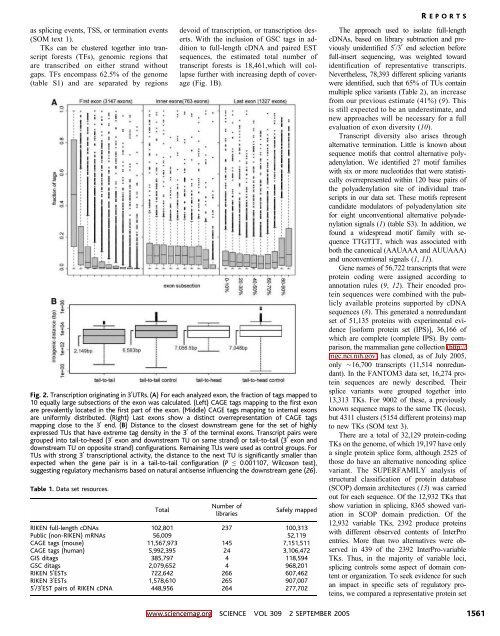THIS WEEK IN
THIS WEEK IN
THIS WEEK IN
Create successful ePaper yourself
Turn your PDF publications into a flip-book with our unique Google optimized e-Paper software.
R EPORTS<br />
as splicing events, TSS, or termination events<br />
(SOM text 1).<br />
TKs can be clustered together into transcript<br />
forests (TFs), genomic regions that<br />
are transcribed on either strand without<br />
gaps. TFs encompass 62.5% of the genome<br />
(table S1) and are separated by regions<br />
devoid of transcription, or transcription deserts.<br />
With the inclusion of GSC tags in addition<br />
to full-length cDNA and paired EST<br />
sequences, the estimated total number of<br />
transcript forests is 18,461,which will collapse<br />
further with increasing depth of coverage<br />
(Fig. 1B).<br />
Fig. 2. Transcription originating in 3UTRs. (A) For each analyzed exon, the fraction of tags mapped to<br />
10 equally large subsections of the exon was calculated. (Left) CAGE tags mapping to the first exon<br />
are prevalently located in the first part of the exon. (Middle) CAGE tags mapping to internal exons<br />
are uniformly distributed. (Right) Last exons show a distinct overrepresentation of CAGE tags<br />
mapping close to the 3 end. (B) Distance to the closest downstream gene for the set of highly<br />
expressed TUs that have extreme tag density in the 3 of the terminal exons. Transcript pairs were<br />
grouped into tail-to-head (3 exon and downstream TU on same strand) or tail-to-tail (3 exon and<br />
downstream TU on opposite strand) configurations. Remaining TUs were used as control groups. For<br />
TUs with strong 3 transcriptional activity, the distance to the next TU is significantly smaller than<br />
expected when the gene pair is in a tail-to-tail configuration (P e 0.001107, Wilcoxon test),<br />
suggesting regulatory mechanisms based on natural antisense influencing the downstream gene (26).<br />
Table 1. Data set resources.<br />
Total<br />
Number of<br />
libraries<br />
Safely mapped<br />
RIKEN full-length cDNAs 102,801 237 100,313<br />
Public (non-RIKEN) mRNAs 56,009 52,119<br />
CAGE tags (mouse) 11,567,973 145 7,151,511<br />
CAGE tags (human) 5,992,395 24 3,106,472<br />
GIS ditags 385,797 4 118,594<br />
GSC ditags 2,079,652 4 968,201<br />
RIKEN 5ESTs 722,642 266 607,462<br />
RIKEN 3ESTs 1,578,610 265 907,007<br />
5/3EST pairs of RIKEN cDNA 448,956 264 277,702<br />
The approach used to isolate full-length<br />
cDNAs, based on library subtraction and previously<br />
unidentified 5/3 end selection before<br />
full-insert sequencing, was weighted toward<br />
identification of representative transcripts.<br />
Nevertheless, 78,393 different splicing variants<br />
were identified, such that 65% of TUs contain<br />
multiple splice variants (Table 2), an increase<br />
from our previous estimate (41%) (9). This<br />
is still expected to be an underestimate, and<br />
new approaches will be necessary for a full<br />
evaluation of exon diversity (10).<br />
Transcript diversity also arises through<br />
alternative termination. Little is known about<br />
sequence motifs that control alternative polyadenylation.<br />
We identified 27 motif families<br />
with six or more nucleotides that were statistically<br />
overrepresented within 120 base pairs of<br />
the polyadenylation site of individual transcripts<br />
in our data set. These motifs represent<br />
candidate modulators of polyadenylation site<br />
for eight unconventional alternative polyadenylation<br />
signals (1) (table S3). In addition, we<br />
found a widespread motif family with sequence<br />
TTGTTT, which was associated with<br />
both the canonical (AAUAAA and AUUAAA)<br />
and unconventional signals (1, 11).<br />
Gene names of 56,722 transcripts that were<br />
protein coding were assigned according to<br />
annotation rules (9, 12). Their encoded protein<br />
sequences were combined with the publicly<br />
available proteins supported by cDNA<br />
sequences (8). This generated a nonredundant<br />
set of 51,135 proteins with experimental evidence<br />
Eisoform protein set (IPS)^, 36,166 of<br />
which are complete (complete IPS). By comparison,<br />
the mammalian gene collection (http://<br />
mgc.nci.nih.gov) has cloned, as of July 2005,<br />
only È16,700 transcripts (11,514 nonredundant).<br />
In the FANTOM3 data set, 16,274 protein<br />
sequences are newly described. Their<br />
splice variants were grouped together into<br />
13,313 TKs. For 9002 of these, a previously<br />
known sequence maps to the same TK (locus),<br />
but 4311 clusters (5154 different proteins) map<br />
to new TKs (SOM text 3).<br />
There are a total of 32,129 protein-coding<br />
TKs on the genome, of which 19,197 have only<br />
a single protein splice form, although 2525 of<br />
those do have an alternative noncoding splice<br />
variant. The SUPERFAMILY analysis of<br />
structural classification of protein database<br />
(SCOP) domain architectures (13) was carried<br />
out for each sequence. Of the 12,932 TKs that<br />
show variation in splicing, 8365 showed variation<br />
in SCOP domain prediction. Of the<br />
12,932 variable TKs, 2392 produce proteins<br />
with different observed contents of InterPro<br />
entries. More than two alternatives were observed<br />
in 439 of the 2392 InterPro-variable<br />
TKs. Thus, in the majority of variable loci,<br />
splicing controls some aspect of domain content<br />
or organization. To seek evidence for such<br />
an impact in specific sets of regulatory proteins,<br />
we compared a representative protein set<br />
www.sciencemag.org SCIENCE VOL 309 2 SEPTEMBER 2005 1561
















